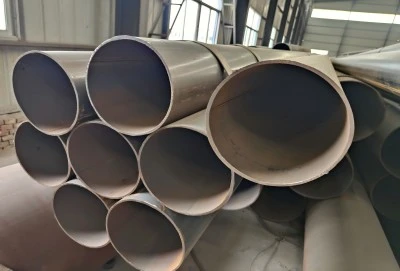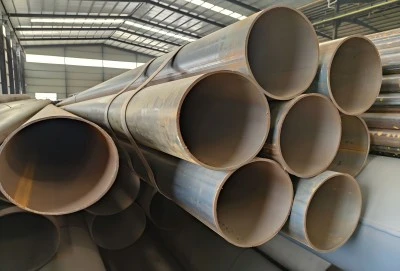When it comes to industrial piping solutions, understanding the differences between various types of pipes is crucial for making informed decisions. Two commonly used pipe types in the industry are electric resistance welded (ERW) pipes and mild steel (MS) pipes. While both serve essential roles in various applications, they have distinct characteristics that set them apart. In this comprehensive guide, we'll explore the key differences between electric resistance welded pipes and MS pipes, focusing on their chemical composition, manufacturing processes, and strength and durability.
|
|
|
Chemical Composition
The chemical composition of a pipe plays a significant role in determining its properties and performance. Let's examine how ERW pipes and MS pipes differ in this aspect:
Electric Resistance Welded (ERW) Pipes: Electric resistance welded pipes are typically made from high-quality carbon steel. The chemical composition of ERW pipes can vary depending on the specific grade and intended application. However, they generally contain:
- Carbon: 0.10% to 0.30%
- Manganese: 0.30% to 1.50%
- Silicon: 0.10% to 0.35%
- Phosphorus: 0.035% maximum
- Sulfur: 0.035% maximum
The precise percentages of these elements can be adjusted to achieve specific mechanical properties required for different applications. For instance, ERW pipes used in the oil and gas industry may have a slightly different composition compared to those used in construction.
Mild Steel (MS) Pipes: MS pipes, as the name suggests, are made from mild steel, which is a low-carbon steel. The chemical composition of MS pipes typically includes:
- Carbon: 0.16% to 0.30%
- Manganese: 0.70% to 0.90%
- Silicon: 0.40% maximum
- Phosphorus: 0.040% maximum
- Sulfur: 0.040% maximum
The lower carbon content in MS pipes makes them more ductile and easier to weld compared to higher carbon steels. This characteristic makes MS pipes suitable for a wide range of general-purpose applications.
The key difference in chemical composition lies in the carbon content and the presence of alloying elements. ERW pipes often have a more controlled and specific composition to meet stringent industry standards, while MS pipes have a more general composition suitable for everyday applications.
Manufacturing Process
The manufacturing processes for electric resistance welded pipes and MS pipes differ significantly, which contributes to their unique properties and applications:
Electric Resistance Welded (ERW) Pipe Manufacturing:
- Coil Preparation: The process begins with a flat steel strip or coil, which is carefully selected based on the required chemical composition and mechanical properties.
- Forming: The steel strip is fed through a series of rollers that gradually bend it into a tubular shape. This continuous process ensures a consistent diameter along the length of the pipe.
- Welding: As the edges of the formed tube come together, they are welded using the electric resistance welding method. This involves passing a high-frequency electric current through the edges, heating them to fusion temperature.
- Pressure: Simultaneously, pressure is applied to forge the heated edges together, creating a solid, seamless weld.
- Cooling: The welded pipe is then cooled rapidly to ensure proper crystallization of the weld area.
- Sizing and Straightening: The pipe passes through sizing rolls to achieve the exact specified diameter and is straightened to ensure uniformity.
- Heat Treatment: Depending on the application, the pipe may undergo heat treatment to enhance its mechanical properties.
- Testing and Inspection: Rigorous quality control measures, including non-destructive testing, are performed to ensure the pipe meets industry standards.
The electric resistance welding process results in a high-quality, uniform weld that is often indistinguishable from the base metal in terms of strength and durability.
Mild Steel (MS) Pipe Manufacturing:
- Raw Material Preparation: MS pipes start with steel billets or ingots, which are heated to high temperatures in a furnace.
- Piercing: The heated steel is then pierced using a mandrel to create a hollow tube.
- Rolling: The hollow tube is rolled and stretched to achieve the desired diameter and wall thickness.
- Cooling: The pipe is cooled in a controlled manner to ensure proper crystallization and avoid warping.
- Straightening: The cooled pipe is straightened to meet dimensional specifications.
- Finishing: The pipe may undergo surface treatments or coatings depending on the intended application.
- Testing: Quality control measures are implemented to ensure the pipe meets required standards.
The seamless nature of MS pipes produced through this method can offer advantages in certain applications where weld integrity is a critical factor.
The key difference in manufacturing lies in the welding process for ERW pipes versus the seamless formation of MS pipes. This difference impacts the properties and applications of each type of pipe.
Strength and Durability
The strength and durability of pipes are crucial factors in determining their suitability for various applications. Let's compare ERW pipes and MS pipes in these aspects:
Electric Resistance Welded (ERW) Pipes:
- Tensile Strength: ERW pipes typically have higher tensile strength compared to MS pipes. Depending on the grade, ERW pipes can have tensile strengths ranging from 330 MPa to over 500 MPa.
- Yield Strength: The yield strength of ERW pipes is also generally higher, often ranging from 205 MPa to 360 MPa or more, depending on the grade.
- Weld Integrity: The electric resistance welding process creates a high-quality weld that is often as strong as the base metal. This results in uniform strength along the entire length of the pipe.
- Pressure Resistance: ERW pipes are known for their excellent pressure-bearing capacity, making them suitable for high-pressure applications in industries like oil and gas.
- Corrosion Resistance: While the base corrosion resistance is similar to MS pipes, ERW pipes can be more easily coated or lined to enhance their corrosion resistance for specific applications.
Mild Steel (MS) Pipes:
- Tensile Strength: MS pipes generally have lower tensile strength compared to ERW pipes, typically ranging from 330 MPa to 410 MPa.
- Yield Strength: The yield strength of MS pipes is also lower, usually ranging from 195 MPa to 215 MPa.
- Seamless Construction: The seamless nature of MS pipes can provide uniform strength throughout the pipe, which can be advantageous in certain applications.
- Ductility: MS pipes are known for their high ductility, making them less prone to brittle failure and more suitable for applications involving bending or forming.
- Weldability: The lower carbon content of MS pipes makes them easier to weld, which can be advantageous in construction and fabrication.
In terms of durability, both ERW pipes and MS pipes can offer long service lives when properly selected for their intended applications and maintained. However, ERW pipes often have an edge in high-stress or high-pressure environments due to their higher strength properties.
It's important to note that the strength and durability of both types of pipes can vary significantly based on the specific grade and manufacturing process. Always consult industry standards and manufacturer specifications when selecting pipes for a particular application.
Longma Group
Understanding the differences between electric resistance welded pipes and MS pipes is crucial for making informed decisions in various industrial applications. While both types of pipes have their strengths, ERW pipes often stand out in terms of strength, pressure resistance, and uniformity, making them an excellent choice for demanding environments.
Longma Group Electric Resistance Welded Steel Pipe is manufactured to meet a range of industry standards, ensuring quality and reliability. Adhering to specifications from API 5L, ASTM A53, ASTM A500, ASTM A252, and ASTM A795, these pipes are designed for various applications in the oil, gas, and construction industries, providing a robust solution for both structural and pressure piping needs. If you are choosing your electric resistance welded pipe manufacturers, welcome to contact LONGMA GROUP at info@longma-group.com.














